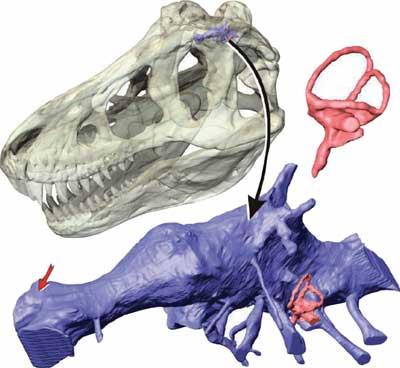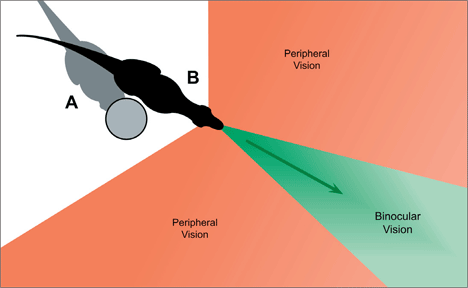T.rex Senses
Dinosaurs Forum Topic

Rex Fan 684
MemberCompsognathusJul 28, 20147145 Views41 RepliesSo I've been doing some research(more than usual) about the senses of T.rex. What I found was amazing.
Time to get all technical and stuff...
Vision-
A study published by Kent Stevens of the University of Oregon concluded that Tyrannosaurus had keen vision. By applying modified perimetry to facial reconstructions of several dinosaurs including Tyrannosaurus, the study found that Tyrannosaurs had a binocular range of 55 degrees, surpassing that of modern hawks, and had 13 times the visual acuity of a human, thereby surpassing the visual acuity of an eagle which is only 3.6 times that of a person. This would have allowed Tyrannosaurs to discern objects as far as 6 km away, which is greater than the 1.6 km that a human can see.
Thomas Holtz Jr. would note that high depth perception of Tyrannosaurus may have been due to the prey it had to hunt; noting that it had to hunt horned dinosaurs such as Triceratops, armored dinosaurs such as Ankylosaurus and the duck billed dinosaurs may have had complex social behaviors. He would suggest that this made precision more crucial for Tyrannosaurus enabling it to, "get in, get that blow in and take it down." In contrast, Acrocanthosaurus had limited depth perception because they hunted large sauropods, which were relatively rare during the time of Tyrannosaurus
Smell-

Tyrannosaurus is notable for having very large olfactory bulbs and olfactory nerves relative to their brain size, the organs responsible for a heightened sense of smell. This suggest that the sense of smell was highly developed, and implying that tyrannosaurs could detect carcasses by scent alone across great distances. The sense of smell in tyrannosaurs may have been comparable to modern vultures, which use scent to track carcasses for scavenging. Research on the olfactory bulbs has shown that Tyrannosaurus rex had the most highly developed sense of smell of 21 sampled non-avian dinosaurs species.
Hearing-

Somewhat unusually among theropods, T. rex had very long cochlea of the ear. The length of the cochlea is often related to hearing acuity, or at least the importance of hearing in behavior, implying that hearing was a particularly important sense to tyrannosaurs. Specifically, data suggests thatTyrannosaurus rex heard best in the low-frequency range, and that low-frequency sounds were an important part of tyrannosaur behavior.
Intelligence-

A study by Grant R. Hurlburt, Ryan C. Ridgely and Lawrence Witmer would obtain estimates for Encephalization Quotients (EQs), based on reptiles (REQs) and based on birds (BEQs), as well estimates for the ratio of cerebrum to brain mass. The study would conclude that Tyrannosaurus had the relatively largest brain of all adult non-avian dinosaurs with the exception of certain small maniraptoriforms ( Bambiraptor, Troodon and Ornithomimus).
How about all that. T.rex had quite the array of senses and smarts. Just figured I'd share that with you all.
Replies to T.rex Senses
Hey Guest, want to add your say?
Are you an avid Jurassic World fan looking for a dedicated online community of likeminded fans? Look no further! Create your own profile today and take part in our forums and gain XP points for all the content you post!










